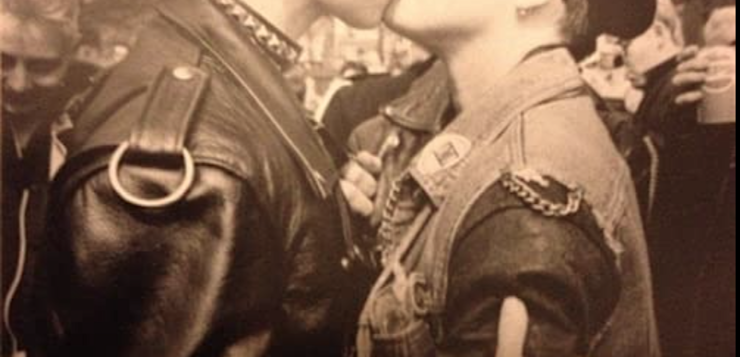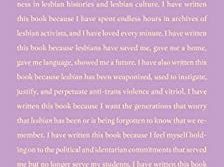I
IN 1988, a headline ran in the UK news: “Beeb Man Sits on Lesbian.” I was four years old and living in a small house on a dead-end road in North Yorkshire with my parents and younger brother, one year away from starting school. The comedic headline referred to a gutsy, brilliant piece of direct action in which a group of dykes infiltrated the BBC building and chained themselves to news desks to protest Section 28, which prohibited the “promotion” of homosexuality. During the 6 o’clock news on 23 May 1988, broadcasters Sue Lawley and Nicholas Witchell were interrupted by protesters padlocked to their desks shouting “Stop the Clause” and “Stop Section 28.” I have no idea whether my parents saw this, or whether they had any idea about the protests happening in London.
But Section 28 went into effect in Thatcher’s Britain in May 1988, and it lasted fifteen years—ending the year after I finished my A-Level Exams, when I left my small Yorkshire town for a bigger Yorkshire city. My entire school life was spent under Section 28, which might go some way toward explaining why I had no idea that there were gangs of dykes chaining themselves to news desks, starting up S/M clubs, protesting nuclear weapons, fucking each other in public, or playing in bands. Section 28 was so effective that I, a closeted adolescent dyke, didn’t even know it existed until it was over.
II
I had a visceral reaction to Rebel Dykes, a long-awaited documentary directed by Harri Shanahan and Sîan Williams about a group of punk dykes in 1980s London. I think about how different my life, and the lives of many queer people my age, might have been different if we’d had ready access to this recent history as teens, to the fact that rebel dykes existed in a tangible sense.
When I first moved to London in 2008, I started reading Jaime Hernandez’ Love & Rockets comics and fell in love with Hopey Glass, a riotous, openly queer punk with excellent hair and a love of leather boots and booze. After spending time with lesbians that I liked very much but felt apart from, Hopey was the closest I had come to being able to define my sexuality, my gender, my restlessness. Like Hopey, I wanted to be drunk constantly, to watch bands, to stay up all night having sex. I wanted to have Hopey’s unwavering confidence. The fact she was created by a cisgender straight man did not escape me, but Hopey was a real lifesaver for me in so many ways. Years later, watching Rebel Dykes, here were our own homegrown versions of Hopey: same clothes, same haircuts, same radical (mis)behaviors.
This essay first appeared online to mark the 2021 BFI Flare premiere of Rebel Dykes. It is part of Culture Club, a community publishing venture from the queer feminist film curation collective Club des Femmes.







